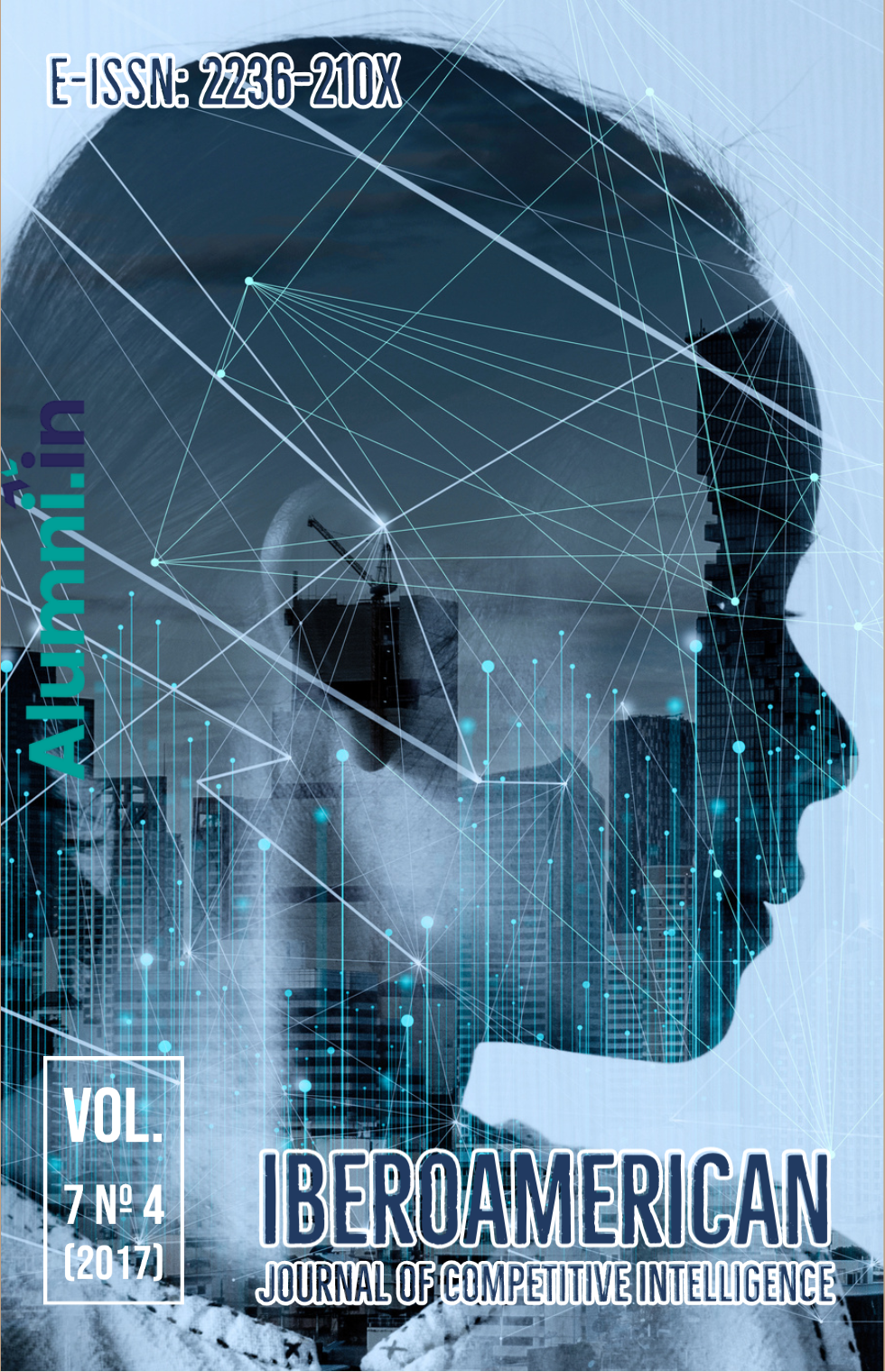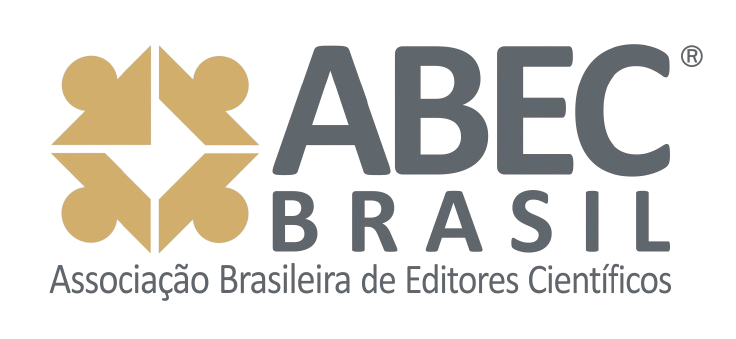Identificação de competências para a animação da Inteligência Estratégica Antecipativa e Coletiva: proposição de ferramenta para acompanhamento de animadores novatos
DOI:
https://doi.org/10.24883/IberoamericanIC.v7i4.242Keywords:
Inteligência Estratégica Antecipativa e Coletiva, animação, competências, acompanhamento, práticas de Inteligência.Abstract
Este artigo apresenta uma ferramenta para o desenvolvimento de competências para a animação de um processo de Inteligência Estratégica Antecipativa e Coletiva (IEAc). Esta ferramenta se endereça a gestores e chefes de projeto com necessidade de implantar e animar um disposisito de IEAc. Este processo de desenvolvimento de competências se estabelece graças a aplicação de uma ferramenta de acompanhamento « passo à passo » e à distância (e-coaching) de animadores noviços, a qual permite transmitir conhecimentos acionáveis sob a forma de conselhos. Este acompanhamento foi verificado empiriamente através de 3 experimentos, dentre os quais um via Internet. O objetivo deste artigo é mostrar, inicialmente, as competências necessárias para animar um dispositivo de IEAc. Em seguida, ele apresenta uma ferramenta de acompanhamento destinada a chefes de projeto, sua experimentação e resultados, os quais permitiram, por um lado, aos animadores acompanhados, de desenvolver suas competências, e por outro, do lado das empresas, de otimizar práticas de inteligência já existentes.Downloads
References
ANALAOUI, F. e KARAMI, A. (2002), How Chief executives’ perception of the environ-ment impacts on company performance, Journal of Management Development. Vol.21, n°4, pp. 290-305. DOI: https://doi.org/10.1108/02621710210430281
ANSOFF, H. I. (1990), Using Weak Signals, Real-Time strategic response, pp.383-399.
ANZIEU, D. e MARTIN, J.Y. (1982), La dynamique des groupes restreints. Presses universitaires de France, Paris. 7éme édition, 396 p.
ARGYRIS, C. (1995), Savoir pour agir : surmonter les obstacles à l’apprentissage, Inter Edition.
BAUMARD, P. ; DONADA, C. ; IBERT, J. ; XUEREB, J-M. (1999), La collecte des données et la gestion de leurs sources, In R.-A. THIETART et al. (eds.), Méthodes de recherche en science de gestion, Paris : Dunod, pp. 224-256.
BERNHARDT, D.C. (1994), ‘I want it fast, factual, actionable’ – Tailoring Competitive Intelligence to Executives’ Needs, Long Range Planning, Vol 27, n°1, pp12-24. DOI: https://doi.org/10.1016/0024-6301(94)90003-5
BOULIFA, I. (2008), Identification des facteurs critiques de succès pour la mise en place de dispositifs de veille stratégique. Doctorat en gestion. ISG/ETHICS Tunis – CERAG/UPMF Grenoble. 3 Juillet 2008.
BOURNOIS, F. e ROMANI, P.J. (2000), L'intelligence économique et stratégique dans les entreprises françaises, Institut des Hautes Etudes de Défense Nationale, Préface de Christian Pierret, Editions Economica, Paris, 278 p.
CARON-FASAN, M.L. (1997), Veille Stratégique : Création de sens à partir de signaux faibles. Thèse pour le doctorat en Sciences de Gestion, UPMF, ESA, ED 275, Grenoble 2. 11 septembre 1997.
CHANAL, V. ; LESCA, H. ; MARTINET, A.C. (1997), Vers une ingénierie de la recherche en sciences de gestion, Revue Française de Gestion, n°116, nov.-déc., pp.41-51. DOI: https://doi.org/10.3166/RFG.253.213-229
CHARREIRE, S. e DURIEUX, F. (1999), Explorer et Tester, In THIETART R.A. et al. (1999), Méthodes de recherche en science de gestion, Dunod, Paris, pp. 57-80.
CHOO, C.W. (1997), Information Management for the intelligent organization : The art of scanning the environment, Library software Review, Westport ; Tona Henderson (Abstract reviewed).
CHOUK, S. (2005), Veille Anticipative Stratégique : processus d’attention à l’environnement, Application à des PMI tunisiennes. Thèse de doctorat en Sciences de Gestion, UPMF, ED 275, Grenoble 2. 331p.
COSTA, J. (1995), An empirically - based review of the concept of environmental scanning, International Journal of Contemporary Hospitality Management, Bradford, http://proquest.umi.com, pp. 1-8.
DESQ, S. ; FALLERY, B. ; REIX, R. ; RODHAIN, F. (2000), Systèmes d'Information : 1980-2000, le parcours d'un champ de recherche, In. Recherches et pratiques en gestion, sous la direction de Amann B., Dupuy Y. et Rigal J.J., Editions Dalloz, pp.227-251.
DOUCET, V. e GINGALI, G. (2004), Légitimité de la veille et ses ambiguïtés. Colloque VSST - Veille Stratégique Scientifique & Technologique - Toulouse III. 25-29 Octobre 2004. (site web : http://atlas.irit.fr/COLLOQUES/VSST2004/publi2004.htm).
ENGLEDOW, J.L. E LENZ, R.T. (1985), Whatever Happened to Environmental Analysis, Long Range Planning, Vol 18, n°2, pp 93-106. DOI: https://doi.org/10.1016/0024-6301(85)90027-5
FAVIER, M. et al. (1998), Le travail en groupe à l’âge des réseaux, Economica, Paris, 276 p.
FERNANDEZ, A. (2000), Les nouveaux tableaux de bord des décideurs : le projet décisionnel dans sa totalité, Préface de Gérard Balantzian, Editions d'Organisation, Paris, 2ème édition, 452 p.
FLEISHER, C. S. (2004), Competitive Intelligence Education: Competencies, Sources, and Trends, Information Management Journal, Vol. 38, n°2, pp 56-62.
FLEISHER, C.S. e BENSOUSSAN, B.E. (2007), Business and competitive analysis : effective application of new and classic methods, Financial times press, New Jersey, 2007.
GIBBONS, P.T. e PRESCOTT, J.E. (1996), Parallel competitive intelligence processes in organisations, International Journal of Technology Management, Special issue on informal information flow, Vol.11, n°1/2, pp. 162-179.
HENRY, V. (2001), Elaboration d'une méthodologie et d'une plate-forme de gestion de l'information technique et stratégique, Thèse de doctorat, Université Lumière, Lyon 2.
HERRING, J.P. (1992), The role of Intelligence in Formulating Strategy, Journal of Busi-ness Strategy 1992, pp54-60. DOI: https://doi.org/10.1108/eb039518
HOWELL, M J. e SHEA, C. M. (2001), Individual differences, environmental scanning, innovation framing, and champion behavior : Keys predictors of project performance, The Journal Of Product Innovation Management, Vol.18, pp.15-27. DOI: https://doi.org/10.1111/1540-5885.1810015
JAIN, S.C. (1984), Environmental Scanning in U.S. corporations, Long Range Planning, Vol. 17, n°2, pp.117-128. DOI: https://doi.org/10.1016/0024-6301(84)90143-2
JANISSEK-MUNIZ, R. (2004), Veille anticipative stratégique en PMI : vers un nouvel usage des sites web pour provoquer des informations 'terrain' afin d’amorcer des innovations : concepts, instrumentation et validation. Thèse de doctorat en Sciences de Gestion, UPMF, ED 275, 415 p.
KOENIG, G. (1996), Management stratégique : paradoxes, interactions et apprentissages : construction et gestion des activités, management d'exigences contradictoires, affrontement, évitement et coopération, renforcement et exploration, Editions Nathan, Paris, 543 p.
KOURTELI, L., (2000) Scanning the business environment: some conceptual issues. Benchmarking, Bradford. Vol 7(5), pp. 406-413. DOI: https://doi.org/10.1108/14635770010694340
KRIAA-MEDHAFFER, S. (2006), Veille Anticipative Stratégique, Problématique de l’Animation : Proposition et expérimentations des connaissances actionnables situées. Cas des entreprises tunisiennes, Thèse de doctorat en Sciences de Gestion, UPMF, CERAG-Grenoble, ETHCS-ISG, Tunis.
KRIAA, S. e LESCA, H. (2003), Veille stratégique, exploration de la fonction d’animation : conceptualisation, état d’avancement et perspectives de validation empirique, Actes des 3èmes Journées de l’Association Tunisienne des Sciences de Gestion ‘ATSG’, Tunis-Gammarth.
LACKMAN, C.; SABAN, K.; LANASA, J. (2000), Organizing the Competitive Intelligence Function : A Benchmarking Study, Competitive Intelligence Review, Vol. 11, n°1, pp. 17-27. DOI: https://doi.org/10.1002/(SICI)1520-6386(200031)11:1<17::AID-CIR4>3.0.CO;2-3
LAROCHE, H. e NIOCHE, J.P. (1994), L’approche cognitive de la stratégie d’entreprise, Revue Française de Gestion, n°99, Juin-Juillet-Août, pp. 64-78.
LECLERC, C. (1999), Comprendre et construire les groupes, Les Presses de l'Université Laval, Canada, 317 p.
LESCA, H. (1990), Système d'information pour le management stratégique, 2ème édition, Editions McGraw Hill, Paris, 146 p.
LESCA, H. (2003), Veille Stratégique, la méthode L.E.SCAnning, Ed. ems Management et Société, 190 p.
LESCA, H., et CHOKRON, M. (2002) Intelligence collective pour dirigeants d’entreprise. Retours d’interventions. Revue Systèmes d’Information et Management, 4 (7), pp.65-91.
LESCA, N. et CARON-FASAN, M.-L. (2008) Facteurs d’échec et d’abandon de projets de veille stratégique : retours d’expérience, Revue SIM, vol.13, n°3, sept-2008, pp. 17-42. DOI: https://doi.org/10.3917/sim.083.0017
LESCA, N. (2002), Construction du Sens, le cas de la Veille Stratégique et de l’exploitation collective des signes d’alerte précoce, Thèse de doctorat en Sciences de Gestion, Université Pierre Mendès France, Ecole Doctorale de Sciences de Gestion ED 275, 492 p.
LEVY-LEBOYER, C. (1996), La gestion des compétences, Les éditions des organisations, Paris.
MACK, M. (1995), L’organisations apprenante comme système de transformation de la connaissance en valeur, Revue Française de Gestion, Septembre-Octobre, pp.43-48.
MALGALAIVE, G. (1990), Enseigner à des adultes, PUF, Paris.
MANDON, N. (1991), Analyser des emplois et gestion anticipé des compétences, Céreq Bref, Septembre, n°57.
MARTINET, B. e RIBAULT, J. M. (1989), La veille technologique, concurrentielle et commerciale : sources, méthodologie, organisation, Les Editions d'organisation-Paris, 300 p.
MAC CARTHY, D.D. (1971), La conduite du personnel, 2ème édition, Dunod, Paris, 342 p.
MC GONAGLE, J. J. e VELLA, C. M. (2004), Competitive Intelligence in Action, Information Management Journal, Vol. 38, n°2, pp. 64-68.
MILES, M. B. e HUBERMAN, A. M. (1991), Analyse des données qualitatives : recueil de nouvelles méthodes, Editions De Boeck, 481p.
MILES, M. B. e HUBERMAN, A. M. (2003), Analyse des données qualitatives, Traduction de la 2ème édition américaine par Martine Hlady Rispal, 2ème édition, De Boeck Editions, Paris, 626 p.
ODER, N, (2001), The competitive Intelligence Opportunity, Library Journal, March 1, 2001.
PRESCOTT, J.E. (1995), The evolution of competitive intelligence, International Review of Strategic Management, Vol.6, pp.71-91.
REIX, R. (2000), Systèmes d'information et management des organisations, Editions Vuibert, 426 p
SANT’ANNA, A. S.; DE MORAES, L. F. R.; KILIMNIK, Z.M. Competências individuais, modernidade organizacional e satisfação no trabalho: um estudo de diagnóstico comparativo. RAE-eletrônica, v. 4, n. 1, p. 1-23, 2005. DOI: https://doi.org/10.1590/S1676-56482005000100001
SAVALL, H. e ZARDET, V. (2004), Recherche en sciences de gestion : approche qualimétrique : Observer l’objet complexe, Editions Economica, 432 p.
SIMON, N. e KERN, A. (2001), It would be easy if it weren’t for people, Competitive Intelligence Review, Vol.12, n°1, pp.59-69. DOI: https://doi.org/10.1002/1520-6386(200131)12:1<59::AID-CIR1009>3.0.CO;2-3
SIMPSON, D. (1997), Competitive intelligence can be a bad investment, Journal Of Business Strategy, Vol.18, n°6, pp.8-9. DOI: https://doi.org/10.1108/eb039889
STOFFELS, J.D. (1982), Environmental Scanning for Future Success, Managerial Planning, Vol. 31, n°3, pp.5-12.
TABATONI, P. e JARNIOU, P. (1975), Les systèmes de Gestion : politiques et structures, 1ère édition, Presses Universitaires de France, Paris, 230 p.
USUNIER, J.C. ; EASTERBY-SMITH M. ; THORPE R. (1993), Introduction à la recherche en gestion, Editions Économica, Paris, 233 p.
WACHEUX, F. (1996), Méthodes qualitatives et recherche en gestion, Economica, Paris, 290 p.
Downloads
Published
How to Cite
Issue
Section
License
Authors who publish with this journal agree to the following terms:
1. Authors who publish in this journal agree to the following terms: the author(s) authorize(s) the publication of the text in the journal;
2. The author(s) ensure(s) that the contribution is original and unpublished and that it is not in the process of evaluation by another journal;
3. The journal is not responsible for the views, ideas and concepts presented in articles, and these are the sole responsibility of the author(s);
4. The publishers reserve the right to make textual adjustments and adapt texts to meet with publication standards.
5. Authors retain copyright and grant the journal the right to first publication, with the work simultaneously licensed under the Creative Commons Atribuição NãoComercial 4.0 internacional, which allows the work to be shared with recognized authorship and initial publication in this journal.
6. Authors are allowed to assume additional contracts separately, for non-exclusive distribution of the version of the work published in this journal (e.g. publish in institutional repository or as a book chapter), with recognition of authorship and initial publication in this journal.
7. Authors are allowed and are encouraged to publish and distribute their work online (e.g. in institutional repositories or on a personal web page) at any point before or during the editorial process, as this can generate positive effects, as well as increase the impact and citations of the published work (see the effect of Free Access) at http://opcit.eprints.org/oacitation-biblio.html
• 8. Authors are able to use ORCID is a system of identification for authors. An ORCID identifier is unique to an individual and acts as a persistent digital identifier to ensure that authors (particularly those with relatively common names) can be distinguished and their work properly attributed.













